
Bullying Prevention: Is my Student a Bully?
Learn about the different types of bullying and how to prevent it in the classroom and at home. Find resources and tips to help address this issue.
Table of Contents
Introduction
What is Bullying?
The Different Types of Bullying
What Are the Signs That My Student Is a Bully?
How Can I Help Prevent Bullying in the Classroom?
Bullying Prevention Resources
Introduction
Bullying is a significant problem with long-term consequences, and it should not be ignored when it is witnessed. If a student exhibits signs of bullying, it is critical to be aware of the signs and take appropriate measures to prevent bullying in the classroom. In this article, we will look at the various aspects of bullying, such as its definition, the various forms it can take, and how to tell if a student is a bully. Also, we will discuss how bullying can be avoided both at home and in the classroom.
What is Bullying?
Bullying is defined as repeated and persistent aggressive behavior directed at a specific individual or group of individuals with the intent to harm or distress them. Physical violence, verbal harassment, social isolation, and exclusion from activities are all examples of how it conveys itself. Cyberbullying, a type of bullying that occurs online or through social media, has emerged as a growing concern due to its ability to reach a large audience and the victim's difficulty in escaping it. Bullying has long-term mental and physical consequences for the victim, as well as ethical and moral consequences for the bully.
The Different Types of Bullying
There are four main types of bullying: physical, verbal, relational, and cyber.
Physical bullying can involve bodily harm or damage to personal property. It can also involve threats of violence. This type of bullying is often seen as the most serious because it can result in physical injury.
Verbal bullying involves name-calling, mocking, or threatening behavior. This type of bullying can be just as harmful as physical bullying, especially if it is repeated over time. It can lead to feelings of insecurity, anxiety, and low self-esteem.
Relational bullying involves trying to damage another person's relationships. This can be done by spreading rumors about someone, excluding them from social activities, or purposely making them feel left out. This type of bullying can be very hurtful because it attacks the victim's social life and sense of belonging.
Cyberbullying is a type ofbullying that takes place online or through text messages. It can involve posting mean messages, photos, or videos about someone without their consent. It can also involve sending threats or engaging in harassing behavior. It is often considered to be the most damaging type of bullying because it can reach a wide audience and be difficult for the victim to escape from.
What Are the Signs That My Student Is a Bully?
Most parents tend to think "my child would never", but the reality is that any student can exhibit bullying behaviors. Unexplained aggression, refusal to take responsibility for their actions, and isolation from friends or activities are all behaviors that are commonly exhibited in bullies. It is crucial to take action if you notice any of these signs in your student. You should talk to your student and determine if there is anything in their life that might be causing them to act out. If you suspect that they are being bullied, talk to their teachers and investigate if there have been any incidents of bullying reported. You can also reach out to the parents of other students in your child's class to see if they have witnessed any instances of bullying. If you think your child may be bullying others, it may be beneficial to seek out professional help to address the issue appropriately.
How Can I Help Prevent Bullying in the Classroom?
Educating students about what bullying is and how to identify it is one of the most critical steps that teachers can take to prevent bullying in their classrooms. By teaching students about the different types of bullying and the signs that someone may be being bullied, you can help them feel more comfortable coming to you if they or someone they know is being bullied. It is equally essential to create a safe and supportive classroom environment where all students feel welcome and respected, and everyone feels comfortable participating in class activities. Encouraging students to report any bullying they see or experience is another vital step, and you must respond quickly and effectively to any reports of bullying made.
Bullying Prevention Resources
In conclusion, bullying is a complex problem with a significant impact on the victims, the bullies themselves, and the wider community. Preventing bullying requires a comprehensive and proactive approach, including educating students about bullying, creating a supportive classroom environment, and taking appropriate action when bullying is observed. There are many resources available to assist educators and parents in their efforts to prevent bullying, including online courses and government websites. By working together, we can make a difference in the lives of our school community.
StopBullying.gov is the official anti-bullying site of the U.S. Government. The site provides information on what bullying is, how to identify it, and how to prevent it. The site also includes resources for individuals who are being bullied, as well as for parents, educators, and others who want to help put an end to bullying.
Project Bono (projectbono.com) is a valuable resource for educators and parents interested in preventing bullying. Our Bullying Prevention & Awareness class equips learners with effective strategies to de-escalate bullying situations and emphasizes the long-lasting impact of bullying on everyone involved. Upon completion of the course, learners will receive a certificate of completion at no extra cost. Additionally, we are committed to investing 25% of enrollment proceeds back into communities through our community enrichment efforts across the country. Join us in reducing the burden on taxpayers and promoting safer and more supportive communities.
OUR COURSES
Drag to resize

Project Bono provides the most affordable up-to-date online classes that fulfill court and employer mandates while contributing 25% of proceeds towards charitable causes.
SOCIAL LINKS
RESOURCES
-
About Us
-
Print a Referral
-
Example Certificate
-
Where We're Accepted
Drag to resize
SUPPORT
Drag to resize


Copyright © 2024 Project Bono. All Rights Reserved
Money-Back Guarantee
All of our courses are backed by a 30-day money-back guarantee. If your certificate of completion is not accepted, contact us with proof of decline.
We recommend you confirm that your assigner will accept our certificates before you enroll in any of our courses.
Note: Cryptocurrency payments do not qualify at this time.
We recommend you confirm that your assigner will accept our certificates before you enroll in any of our courses.
Note: Cryptocurrency payments do not qualify at this time.
Drugs & Alcohol
MIP
Anger
Truancy
Cannabis
Bullying
Theft
Nicotine
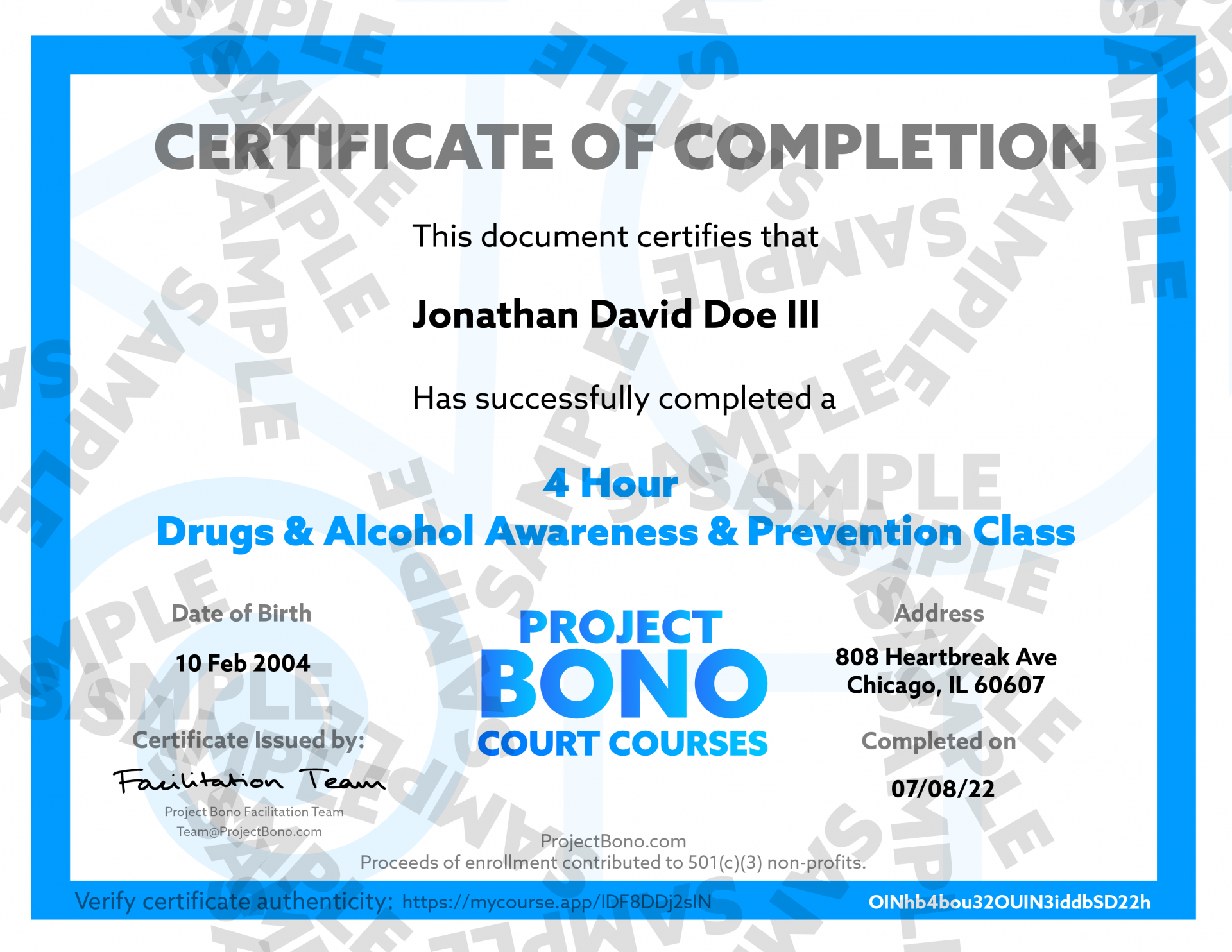
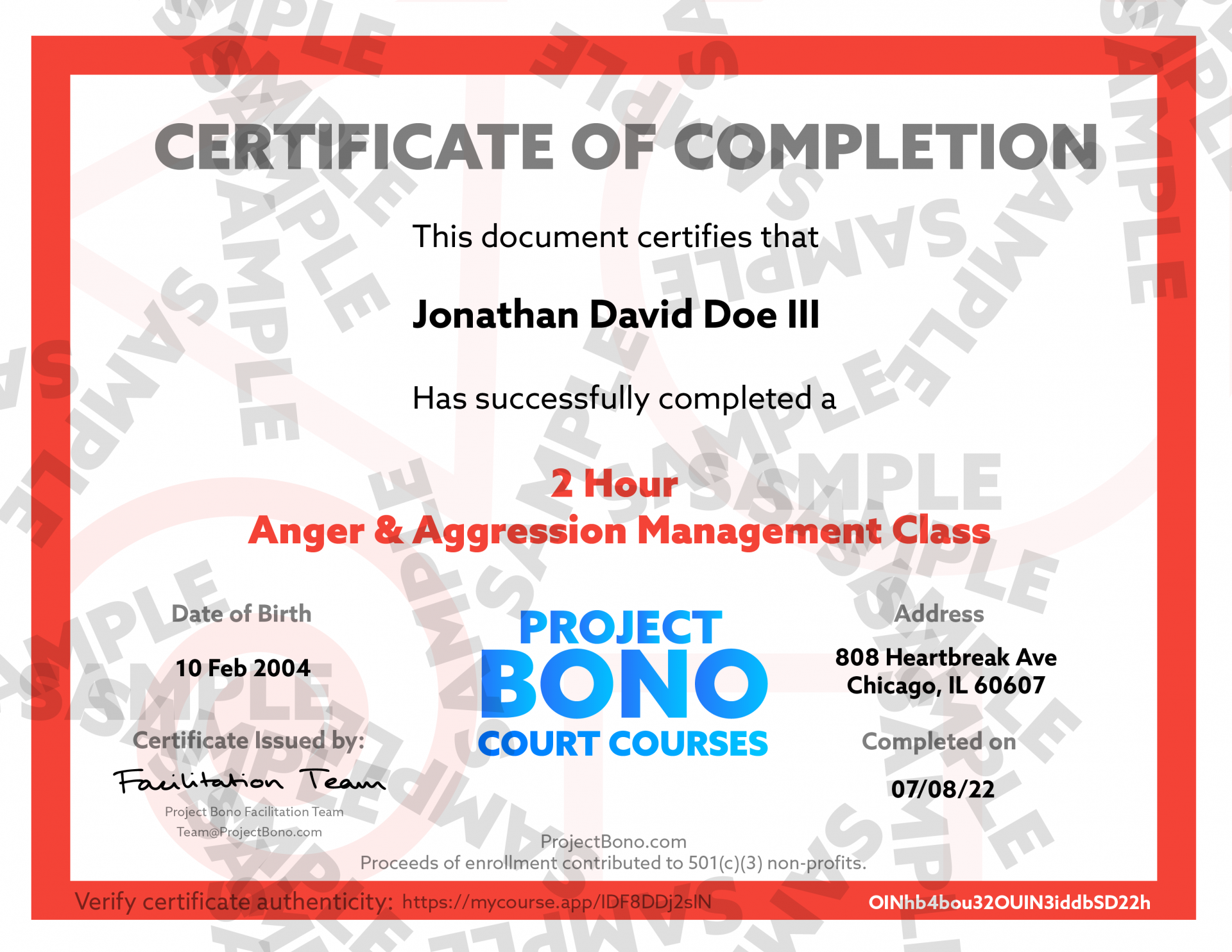
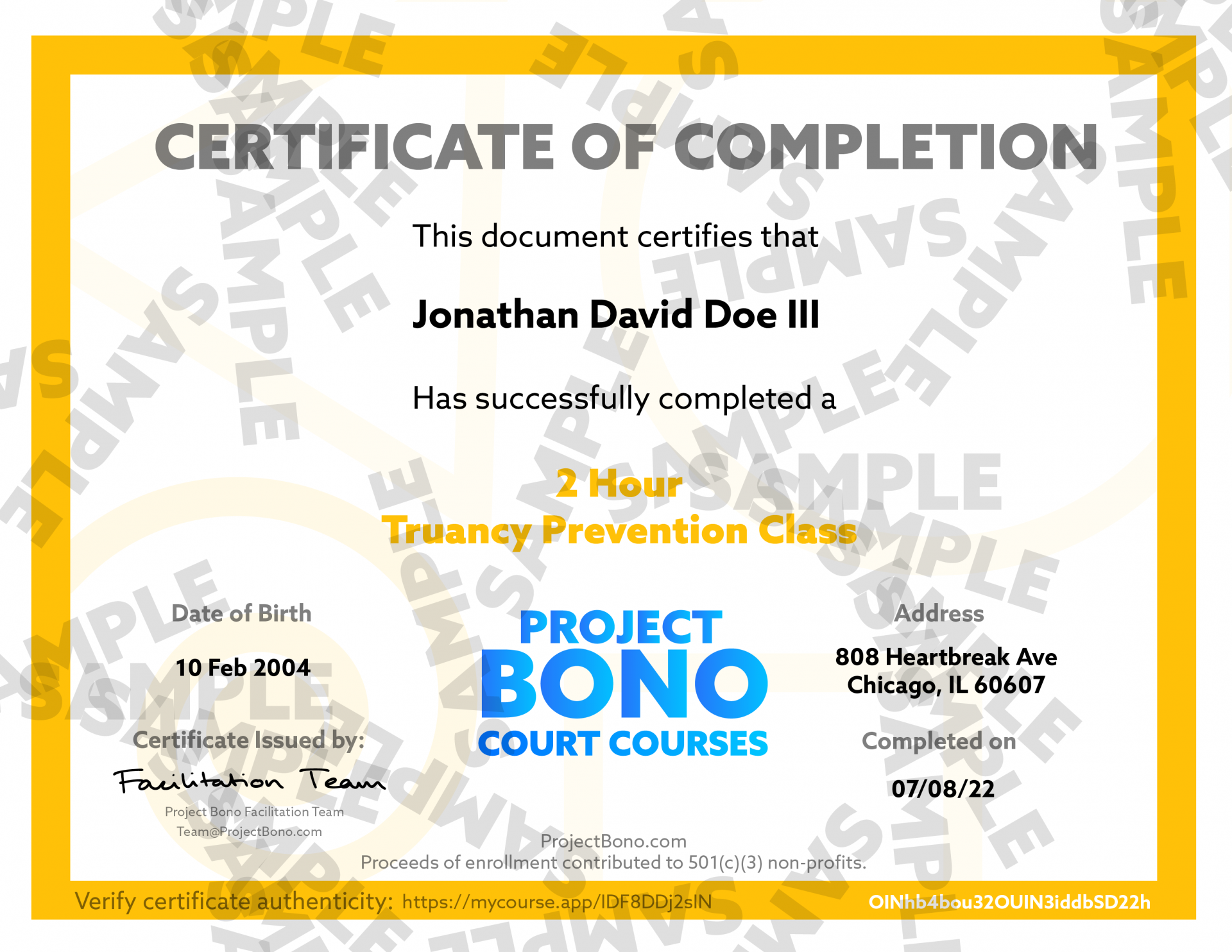
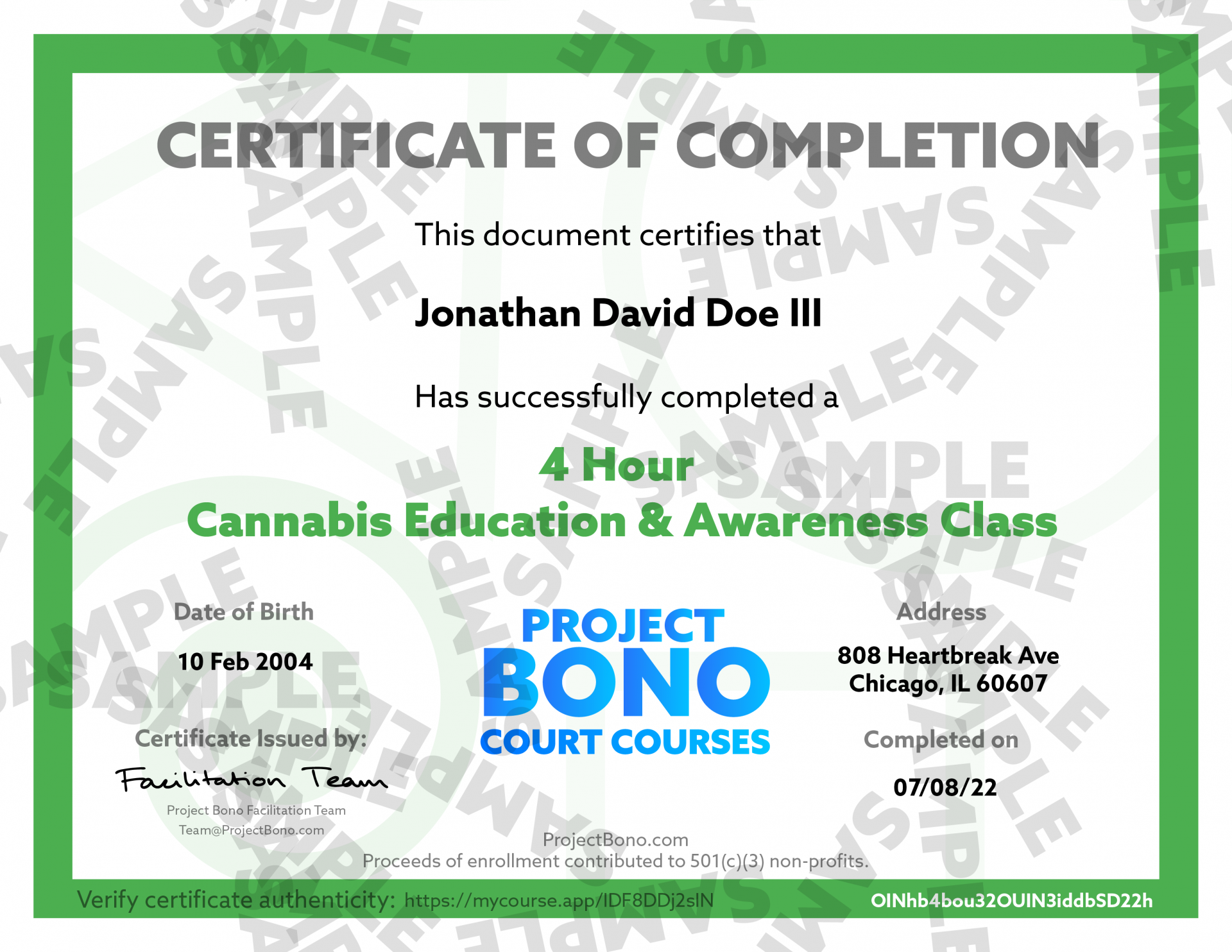
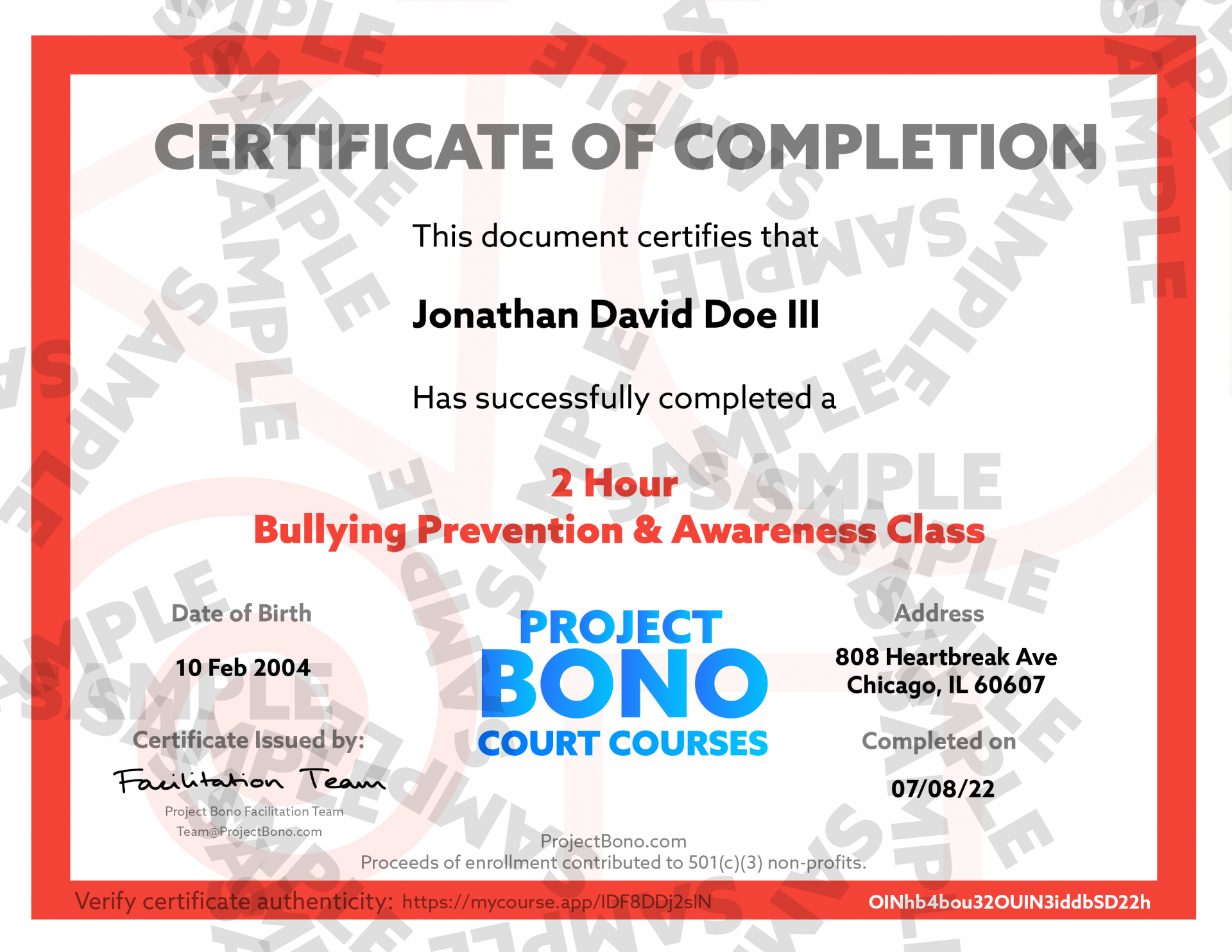
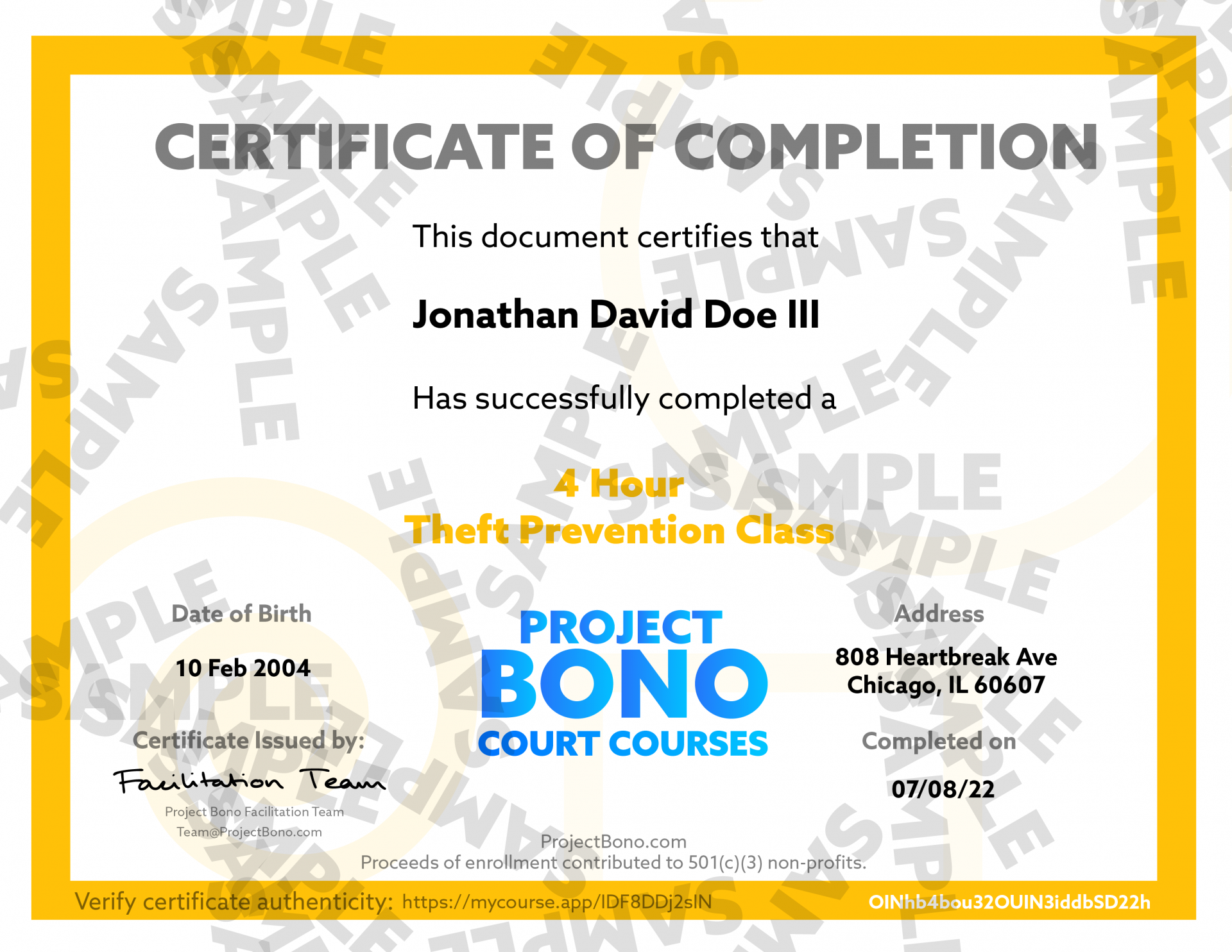
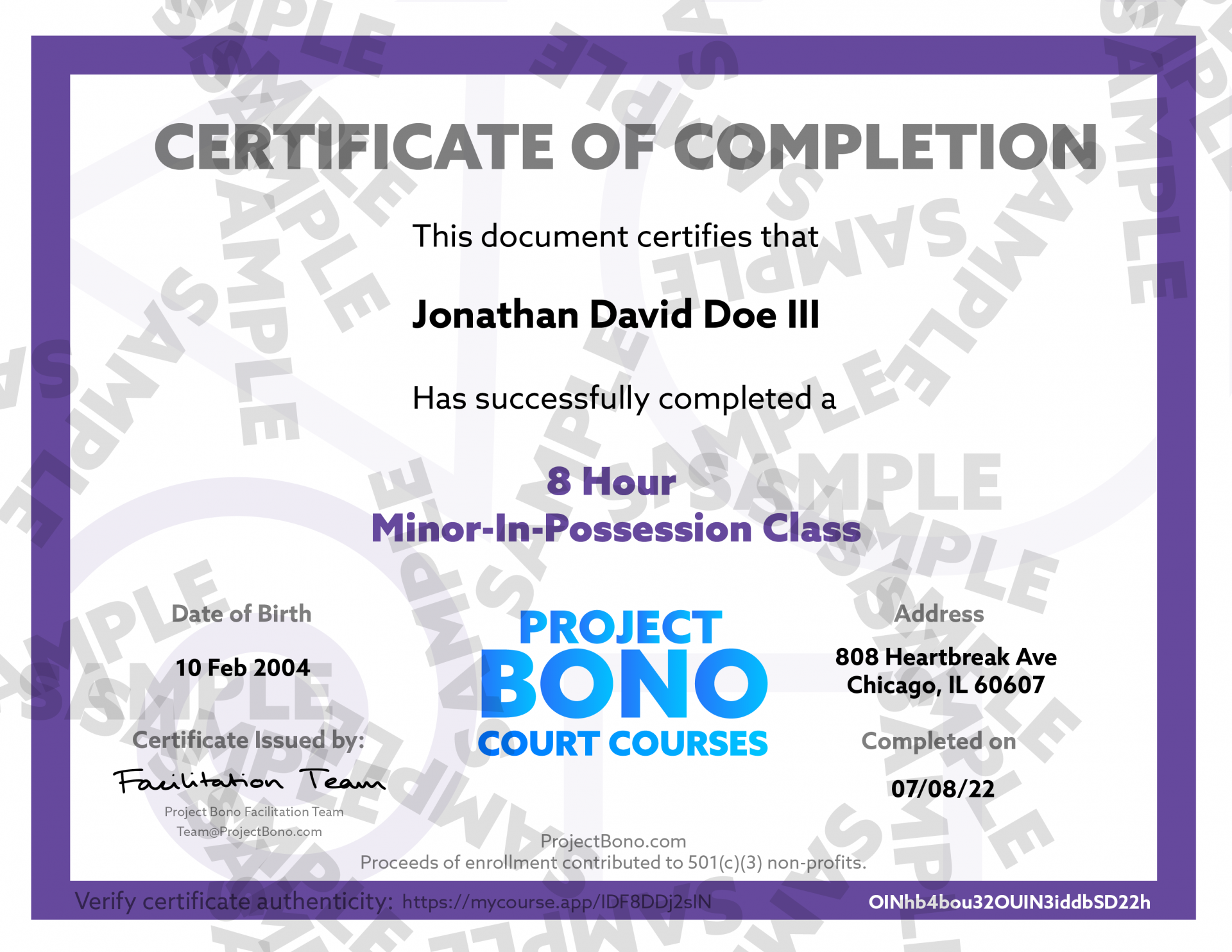
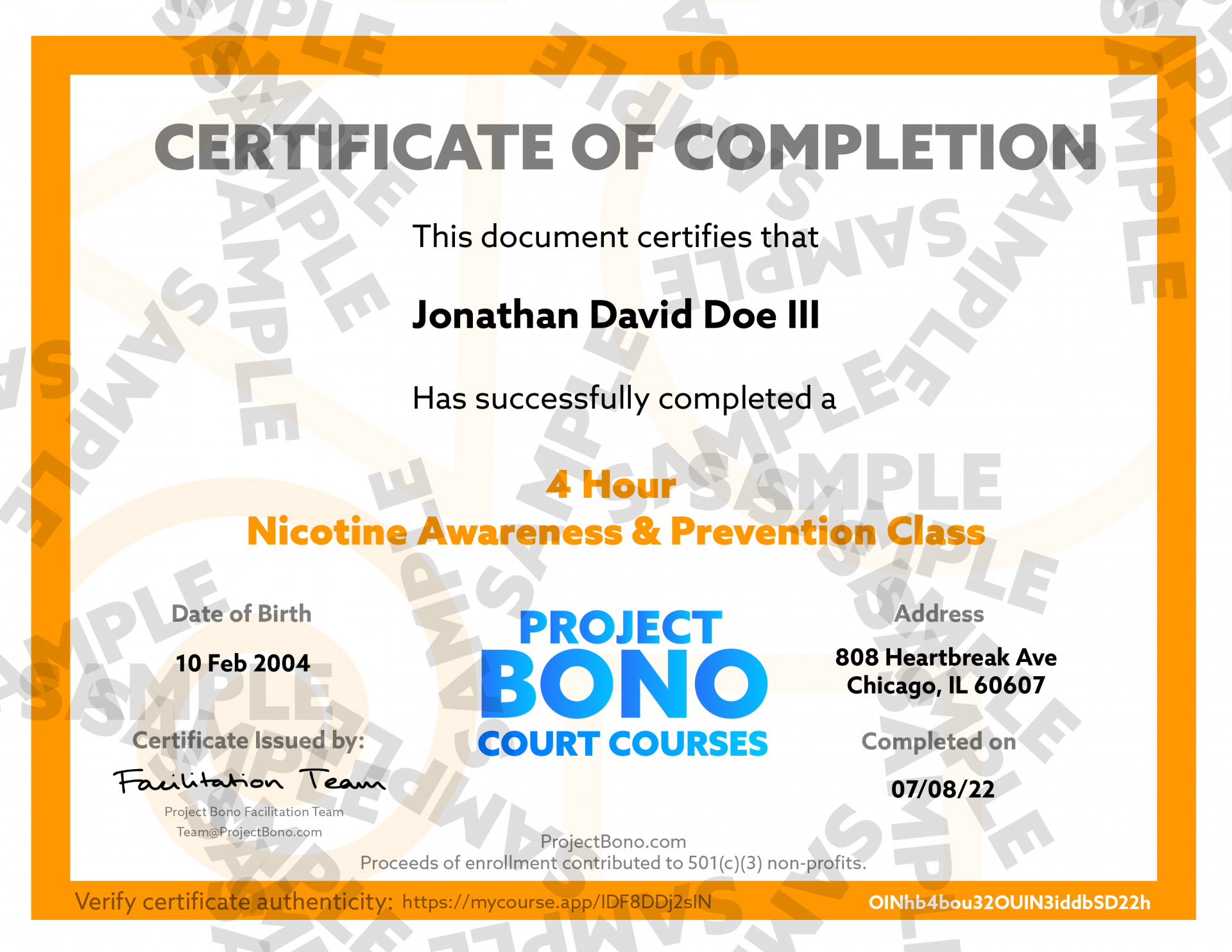
Course updates
Course contents and formatting are subject to improvements.
We are constantly monitoring current scientific and legislative data to provide you with the most accurate information within our courses. When you purchase any of our courses you are entitled to all future versions of the course.
We are constantly monitoring current scientific and legislative data to provide you with the most accurate information within our courses. When you purchase any of our courses you are entitled to all future versions of the course.
PrintableHandouts
Download and print PDF handouts to easily direct students to the correct course and start assigning!
How does Project Bono work?
Project Bono offers correctional education programs that aim to educate first-time and repeat offenders about the risks associated with substance abuse and harmful behaviors.
As you progress through our courses, you'll have access to various forms of media, including videos, to help you understand the material.
Once you've completed the course and met the time requirement, you'll receive a certificate of completion that you can share with your court, school, or employer.
As you progress through our courses, you'll have access to various forms of media, including videos, to help you understand the material.
Once you've completed the course and met the time requirement, you'll receive a certificate of completion that you can share with your court, school, or employer.
One thing that makes Project Bono stand out is that we donate 25% of enrollment proceeds back to the communities that assign our programs.
This means that by assigning our programs, not only are individuals learning valuable life skills and building awareness, but they are also enriching the communities that assign our programs.
This means that by assigning our programs, not only are individuals learning valuable life skills and building awareness, but they are also enriching the communities that assign our programs.
What Programs are offered?
We cover a wide range of topics including Drugs & Alcohol Awareness, Cannabis Education, Minor in Possession (MIP), Nicotine Prevention, Bullying Prevention, Anger Management, Theft Prevention, Truancy Prevention, and more.
We continuously update our programs to reflect current research and trends in substance abuse and other harmful behaviors.
Forgot your Password?
If you forgot your password, you can reset it by clicking on the "Forgot your password?" link on the login page.
If you signed up with an existing social account and the "Forgot your password?" solution doesn't work, you may need to change your password on the existing social account.
If you signed up with an existing social account and the "Forgot your password?" solution doesn't work, you may need to change your password on the existing social account.
Can I take a course on my phone?
Yes!
All of our courses are accessible across any device with a web browser.
All of our courses are accessible across any device with a web browser.
Can I take a course on my phone?
Project Bono is accessible to anyone with a web browser (such as Google Chrome, Safari, Microsoft Edge, etc.), and a stable internet connection. Whether you choose to participate from a desktop computer, laptop, tablet, or smartphone, you should be able to access our programs with ease.
Our website is designed to adjust to your device's screen size and resolution, making it easy to start a course on one device and pick up where you left off on another. If you have any questions about the technology required to participate in our programs, our support team is always here to help.
Our website is designed to adjust to your device's screen size and resolution, making it easy to start a course on one device and pick up where you left off on another. If you have any questions about the technology required to participate in our programs, our support team is always here to help.
What if my certificate is not accepted?
If your certificate of completion is not accepted by a member of the court, counselor, employer, administrator, or any other occupational, educational, or legal assigner, please contact us.
Our certificates come backed with a 30-day acceptance guarantee. If your certificate is not accepted for any reason, please provide us with documented proof of rejection, such as an email or written statement from the assigner.
We always recommend contacting your issuing party before purchasing any of our courses to confirm they will accept your certificate. Please note that refunds in these cases are only granted within the 30-day guarantee period.
How do I request a refund?
If you need to request a refund for any reason, including if your certificate of completion is not accepted by your assignor, you can do so by sending us an email at team@projectbono.com.
To enact our acceptance guarantee, please include in your email a written proof of decline from the assignor that includes a way of reaching them. If the request is within 30 days of your purchase and meets the criteria of our acceptance guarantee, we will process your refund promptly.
Please note that refunds that don't qualify for the acceptance guarantee, such as those requested outside of the 30-day window or for reasons other than non-acceptance by your assignor, are reviewed and issued on a case-by-case basis.
If you have any questions or concerns about requesting a refund, please don't hesitate to contact our customer support team at team@projectbono.com.
Am I able to pause the course?
Yes, participants are able to pause the course and continue at any time, on any device. Our platform is designed to save your progress consistently while you participate in the course, so you can pick up right where you left off. Whether you need to take a break for a few hours or a few days, you can rest assured that your progress will be saved.
We want you to get the most out of our courses and achieve your goals, and that means being able to learn at your own pace and on your own schedule. So go ahead and take a break if you need to - we'll be here when you're ready to continue.
How long does it take to complete a course?
The time it takes to complete a course varies depending on the time requirement you choose. When you enroll in a course, the time requirement will be clearly stated on the course page, along with an estimated completion time based on that requirement.
If you're unsure about which time requirement to choose or have any other questions about course completion time, you should reach out to your assigning party.
What does the certificate look like?
Every certificate generated by Project Bono includes the following information: course title and time requirement, student's name, birth date, address, date of completion, and certificate verification link. This information is unique to each certificate and cannot be duplicated or edited.
We offer certificates in PDF format because it's the most efficient way to send documents over email, while also reducing paper, ink, energy, transportation, and overall costs required to mail a physical copy.
Remember, it's important to submit your certificate of completion to your assignor as soon as possible to avoid any complications. If you have any questions or issues, please contact our support team for assistance.
Hollup.
Who are You?
Acceptance Guarantee
Enhance your assurance with our 30-Day Acceptance Guarantee.
Whenever you enroll in a Project Bono program, you have the peace of mind knowing that our certificate is backed by our Acceptance Guarantee. If your certificate isn't embraced by the assigning entity, we've got you covered.
Simply provide us with a proof of decline, and we'll handle the rest.
Simply provide us with a proof of decline, and we'll handle the rest.
◊ Acceptance Guarantee: Offer is only valid for 30 days from the date of certificate issuance and is available to participants within the U.S. The guarantee is subject to validation of the proof of non-acceptance provided by the enrollee. For detailed information regarding our policy, see support.projectbono.com/acceptance-guarantee.